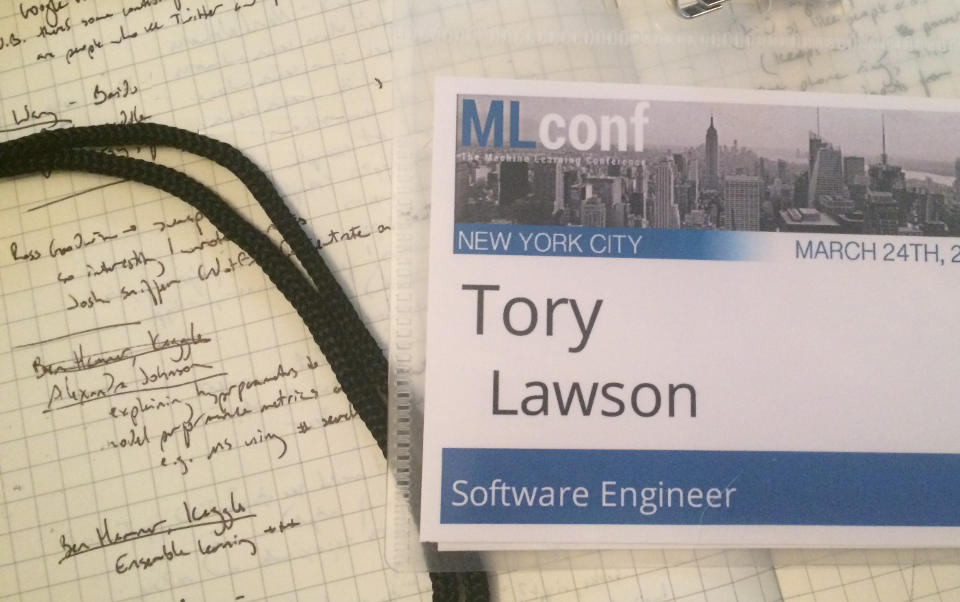new site();


I was fortunate enough to get a student ticket to MLconf 2017, which was exciting because I've never been and the speaker list looked pretty amazing. I kept my mouth shut and took tons of notes, some of which I thought I'd share: 
There were actually two speakers during lunch; the first was Jeff Bradshaw from Adaptris, and they are in the business of applying machine learning to farming and figuring out what combinations of factors bring about the best yields from crops. He pointed out that this is actually of gigantic significance to the parties involved but that gathering data from farmers can be tough. This dovetailed nicely with the talk from Yuri Brovman (eBay), who discussed the challenges of creating a recommendation system when random folks are taking pictures of the products in poor light and then cramming misspellings and other joyously free-form information into the product descriptions.
The first post-lunch talk was by Irina Rish from IBM Watson. Her talk was about using information gathered from studies of the brain to make better AI, and using work in AI to help understand the brain better, and it was truly fascinating stuff--but I just wrote "look up the paper" in my notes, because 30 minutes is not enough to learn about that subject, it really isn't.
After Ms. Rish was Ben Lau from Complus Asset Management, who talked about "Deep Q Learning," which is like using Q learning, but using a neural network for Q. He's one of those speakers who explains everything so well you think you can implement it, but I have a feeling you can't just drop a neural network into your Q-learner and have everything start kicking ass all of a sudden.
Claudia Perlich from Dstillery was next, and she discussed the signal-to-noise problem, specifically pertaining to populations arriving at the same outcome but for different (sometimes opposing) reasons, and the challenges of trying to use temptingly predictive features that hide unpredictable decisions beneath. Then: coffee break! I talked a little bit with a couple of the sponsor company reps but mostly just tried to figure out why they designed the men's room so that everyone in the conference could see you peeing when the door opened.
The home stretch kicked off with Layla El Asri from Maluuba, who talked about reinforcement learning and showed her algorithms playing Pac-Man and so on. (Honestly, I'm pretty sure I could watch that sort of thing all day.) Her specific focus was on creating learners that can "separate concerns"--eat power pellets and avoid ghosts, for instance--in much the same way that we can drive mostly on autopilot, bringing our focus to bear on specific tasks while maintaining speed and direction without much thought. It was a provocative discussion and most people jotted down a note when she mentioned that Maluuba is hiring.
Evan Estola from Meetup gave probably the second-best talk of the day (I have to give the best talk to Corinna Cortes) talking about our responsibility as wranglers of these learners to protect them from learning bigoted or otherwise harmful patterns. He noted that while some people believe that anything the learner infers from the data is somehow pure and bias-free, it is more accurate to say that while we are tinkering with every other constraint and parameter of a model we might as well fix the stuff that yields socially unwelcome inferences. He said it more elegantly of course, but it was neat that he kind of spanked everybody with that.
Aaron Roth from the University of Pennsylvania came up next with a talk on differential privacy, which served as a second sort of cautionary discussion, this time about the responsibility we have to make even anonymized data truly private, and a way of measuring that this has been done. After him came Byron Galbraith from Talla, whom I felt kind of bad for because his talk on "Bayesian Bandits" as a way to do better A/B testing (better from the standpoint of users, and basically the same from the standpoint of the person gathering data) was delivered to a room that was ready to go the second somebody said the word.